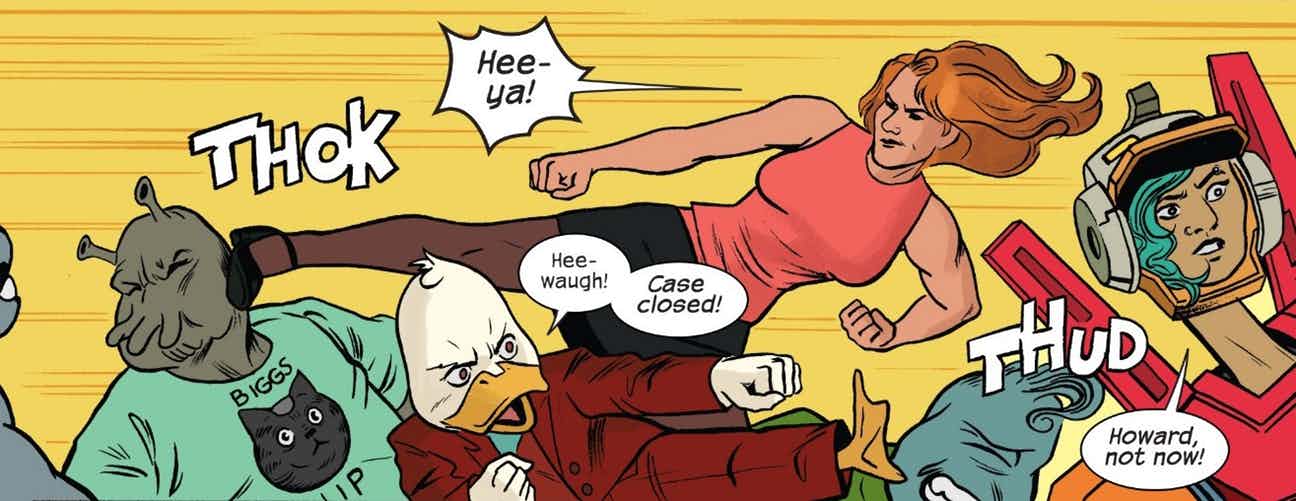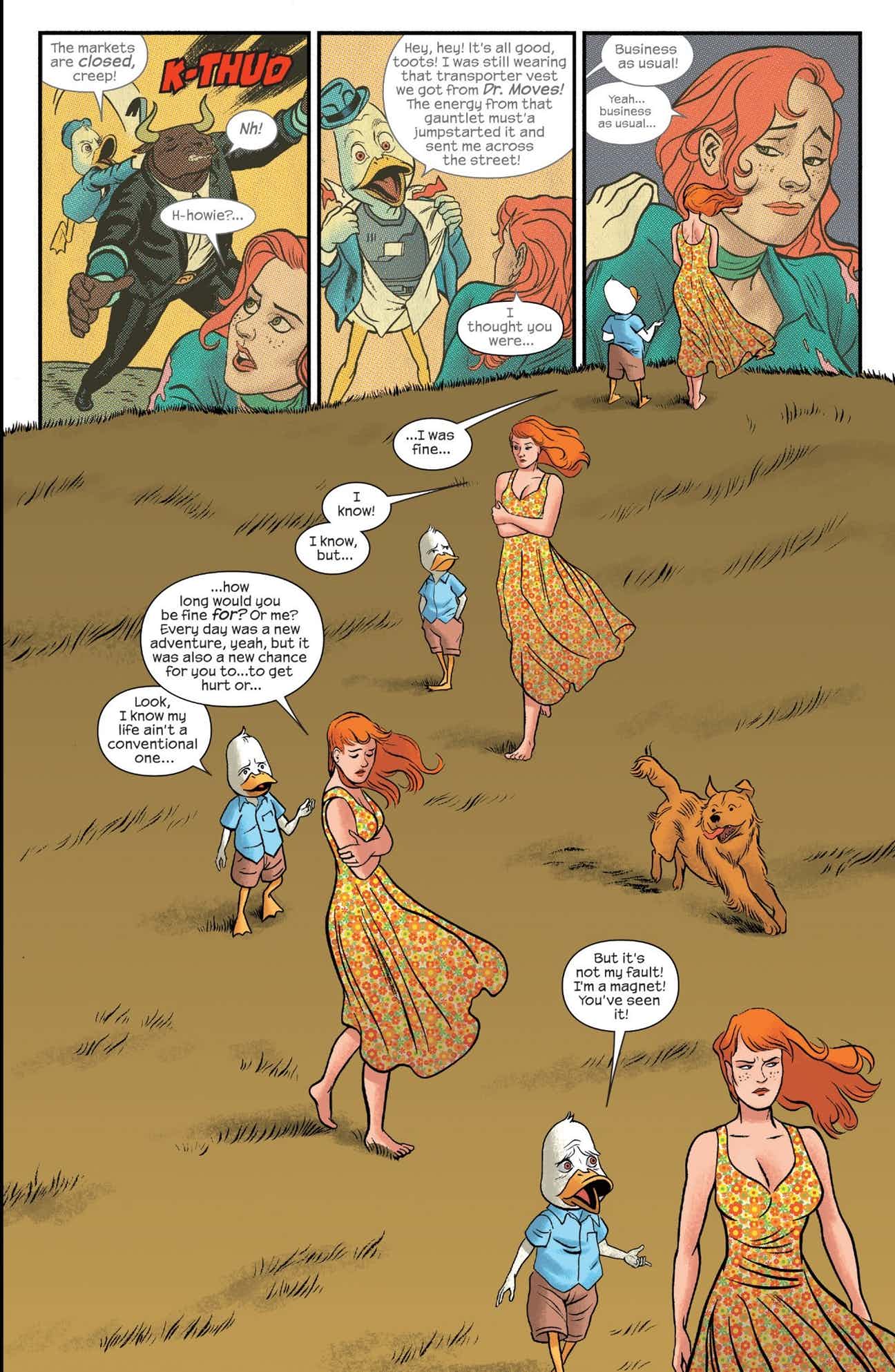
When you’ve been a comic book fan for as long as I have, you start to see the repetition of ideas and concepts within the medium; it’s just inevitable when you have a never-ending publication cycle. As such, events like “Civil War II” usually make me tune out because I’ve been there and seen that before. So, when a book like Chip Zdarsky and Joe Quinones’ “Howard the Duck” rolls along, I’m drawn to it like a duck to wet bread. Since page one, the creators have given us some of the most bizarre and offbeat stories at Marvel Comics, throwing a friendly middle finger to the convention of modern comics publishing while finding a way to humiliate Spider-Man in almost every issue. The series is chock-full of the unexpected, and it continues that tradition in “Howard the Duck” #9, where Lea Thompson guest stars as herself and helps Howard fight Mojo.
If that sounds insane, that’s because it is. Zdarsky and Quinones are out in left field, and they’re owning it. The first volume of the series followed Howard as he stopped the Abundant Glove — a low-rent version of the Infinity Gauntlet — from falling into the hands of a dirtbag Skrull named Talos the Untamed. Since then, the creative team has made Howard the Nexus of Realities, imbued him with the Power Cosmic, hunted him for sport on a billionaire’s private island and found him adopting Quinones’ cat Biggs as part of Howard’s staff. Now, they’re teaming him up with the star of the 1988 Lucasfilm movie, which — well — isn’t quite of the same caliber as the current Marvel Cinematic Universe, to say the least. (I suggest you pull some friends together, go full “MST3K” on it and learn all the words to “Howard The Duck.”)
“Howard the Duck” #9 finds Lea searching for answers because she’s missing pieces of her memory and having weird dreams about a private ducktective living in Brooklyn. The trail leads to a soundstage and some very familiar faces. As it turns out, George Lucas isn’t responsible for Howard’s movie in the Marvel Universe; that honor goes to Mojo, the X-Men villain that looks like a melted pile of butter on mechanical spider legs. Thompson actually seems like the real Beverly Switzler here; she takes it all in with a sense of “why not,” regardless of the situation. When Howard’s assistant Aunt May — yes, that Aunt May — asks for an autograph on a headshot she herself just drew, Lea does it. She holds her own in a fight against Mojo’s weird cronies and even her last line — “We need to wire money to a duck” — is fantastic.

The team takes a lot of storytelling risks throughout the book and, in doing so, stays true to the spirit of the original series by Steve Gerber, which was a metafictional and satirical take on comic books of the 1970s. Gerber threw Howard into any kind of story he wanted, even campaigning for him to run for president in 1976. Zdarsky and Quinones expand on that tone in this issue when it’s revealed that everything in the series has been orchestrated through Mojo by some outside forces, who just so happen to be two aliens that look a hell of a lot like Chip and Joe.
It’s bonkers, all of it, but it feels completely earned. Through all the weirdness thrown at us, this book has always been a character piece about a lonely man looking for a home in a world where he doesn’t fit in. Zdarsky’s comedy is made funnier because he also taps into that sadness; for instance, last issue was a haunting, poignant story that reunited Howard with his old love Beverly, the woman Lea Thompson plays in the film. Zdarsky gave us a bittersweet tale of exes finally seeing each other again, revisiting their highs and lows and wondering where it all went wrong. Quinones’ art in that issue was also experimental and gorgeous, bending page layouts in and out of flashbacks. It was like reading a comic book version of Fleetwood Mac’s “Landslide.”

If Zdarsky and Quinones didn’t utilize that character depth, the jokes would be just an escalating pile of nonsense tethered to vessels without any dimension. When there’s a root to it, the wildness can go anywhere and we can go along with it because we know who our protagonists are. Zdarsky’s comedy work in the series has been stellar — he sends Howard undercover as a regular duck, he paints Johnny Storm as a radical monogamist and he’s made Spider-Man cry in several different issues — but his grounded stuff is just as good.
Quinones also deserves a ton of kudos for this series. His work is astoundingly beautiful and has developed by leaps and bounds. From body language to facial expressions, his character work sells every nuance of the script. Rico Renzi’s colors gave the book a flat, bright vibe that worked in the first volume, but — in this volume — Quinones teams with Jordan Gibson to color his own work, using the palette to soften and shape his art with gradients that make the characters feel more real. Editor Wil Moss also deserves credit for letting this crew run wild, trusting them to turn an outrageous series of events into a cohesive long-form series of events.
With just two issues left in this run, Zdarsky and Quinones bring us even closer to the end in “Howard the Duck” #9, and it’s hard to say when we’ll see anything as fun as Elektra Natchios meeting up with Jennifer Garner to discuss the disaster of “Elektra” or Man-Thing being forced to sit through “Man-Thing” again. For now, though, Marvel continues to publish one of the funniest comics in mainstream entertainment.

